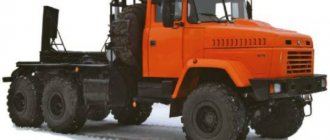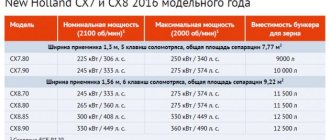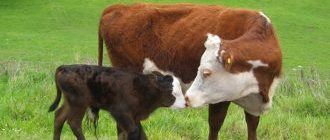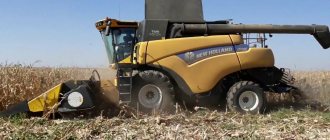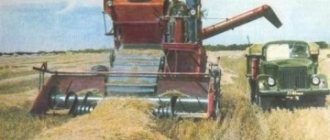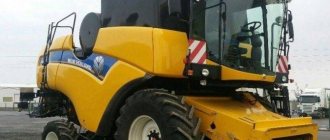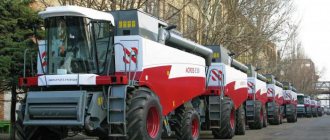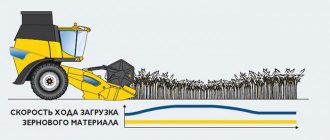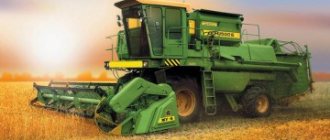The history of New Holland dates back to 1895. From the very first days, agricultural equipment began to roll off the production line, with priority given to feed crushers. In 1952, the first grain harvester rolled off the New Holland assembly line. His system was completely mechanized. From this time on, the triumphant march of combine harvesters of this brand began throughout the countries of the world. The TC 5080 model, which is a representative of the TC 5000 series, has gained particular popularity.
Combine harvester New Holland TC 5080
The TS 5080 combine harvester model is designed for harvesting grain crops. This equipment is able to work in various climatic and weather conditions. During operation, the tractor mechanisms ensure high-quality grain threshing and minimize crop losses, which is due to the high productivity of the equipment.
The New Holland 5080 combine has the following features:
- The threshing system is equipped with a unique separator that reduces grain losses during harvesting by up to 5 percent.
- The grain storage tank is equipped with a hinged conveyor, which evenly distributes the grain mass inside the bunker, maintaining the balance of the equipment.
- The combine header is located close to the soil, which allows you to cut even low-growing crops.
- The grain drum has an increased diameter, this feature allows you to reduce time and resources for cleaning the system.
- The drum control system, including rotation speed and operating mode, is connected to electronic monitors located directly in the driver’s cab.
- A reliable engine cooling system allows you to protect it from overheating in harsh climatic conditions.
The threshing system has a special mechanism that neutralizes maximum loads. This ability reduces the likelihood of mechanism failure due to overload.
Photo of New Holland 5080 combine harvester
Price in Russia
By Russian standards, the cost of the Neve Holland combine is quite high. Even on the secondary market, the average price of a unit is approximately 100-150 thousand dollars. It is even more difficult to talk about new models, since their cost can exceed 300 thousand, depending on the configuration and year of manufacture.
At the same time, thanks to the high-quality modern equipment and endurance of the combines, there is no point in buying new machines, because any used model will be no worse. Of course, in comparison with some other companies, New Holland's price seems disproportionately high, but believe me, it's worth it. Having spent this money once, you will receive a reliable unit for many years, which is very effective in use and can be easily and quickly repaired in case of breakdown.
Concluding this article, it is necessary to once again emphasize all the capabilities of a grain harvesting vehicle: endurance, productivity and efficiency. The manufacturer's policy is to have the best technical equipment, allowing you to operate the machine for a very long time and not spend additional money on constant repairs. The fact that the combine has been repeatedly included in the Book of Records for high productivity and careful treatment of grain crops during processing speaks for itself.
This is interesting: OVS-25 (self-propelled heap cleaner): technical characteristics and design
Device
The main elements and systems in the TC 5080 combine are:
- Threshing drum. It is equipped with a unique separator, the operation of which is regulated by two speed modes. The drum itself is mounted on a powerful frame that can withstand the maximum rotation speed of this device.
- Reapers. They have a durable frame designed to withstand maximum loads. Sharp blades and an adjustable reel deliver the same performance in any crop and under any conditions.
- Engine. It is equipped with turbocharging, which increases engine power. Its reserve is sufficient to work in extreme conditions. A protective dust screen protects it from clogging.
- Transmission. The combine is equipped with a gearbox with four speed modes: three of them are operating speeds, and one is designed for the transport movement of the combine.
- Cabin. It provides the most comfortable working conditions for the operator. There is an air conditioning system, hydraulic steering rack, ergonomic seat, and a windshield with a wide viewing angle.
The box is equipped with a hydrostatic drive, which increases the reliability of the equipment.
History and demand
The history of the brand began much earlier than 1977, which appears in many sources. The main character was Nikolaus August Otto, who founded the world's first company specializing in the production of engines in 1864. Already in 1890, a thresher was invented. 4 years later, the first Deutz tractor with a 26 hp gasoline engine was released. In 1927, the first diesel tractor Deutz MTN222 was produced, which in fact became the beginning of mass production of standard and now familiar tractors.
Since 1936, small agricultural enterprises have already begun to use mechanization and its face - the Deutz F1V 414, with a power of 11 hp.
In 1937 Klöckner was acquired, which became Klöckner-Humboldt-Deutz or simply KHD. This company becomes the largest conglomerate of the Reich. At that time, KHD worked in all areas related to engine production.
Since 1949, the production of tractors with a diesel engine and air cooling Deutz F1514 and F2514 has been launched. Already in 1955, the 100 thousandth copy was produced.
1961 – start of cooperation with Fahr AG. It was made possible through the exchange of shares in KHD. In 1968, KHD bought part of the shares of Fahr AG and a brand appeared that is today recognizable in many countries - Deutz-Fahr.
In 1977, DX series engines were put into mass production, which were officially introduced a year later. These were diesel engines with 5 and 6 cylinders. Their power varied from 80 to 160 hp. A little later, in 1980, the series was also replenished with 4 cylinder models.
In 1990, production of AgroXtra tractors was launched. 1991 Topliner series combine harvester.
1995 became a landmark year, because it was during this period that the Italian group SAME joined the corporation. The full name of the company began to look like this: SAME Deutz-Fahr or SDF. The Agrotron series has also been released.
In 1996, it was decided to move production facilities from Cologne to Lauingen. In the same year, the Gigant 400 forage harvester was introduced. Further history is largely connected with the release of new equipment, namely:
- 2001 – Agrotron TTV with continuously variable transmission.
- 2004 – production of Teleskoplader loaders and rotary combine was launched
- 2009 – production of the Agrotrac series started. It is intended for countries with more flexible gas emission standards.
- 2013 – series of S9000 combines.
The last significant event in the history of the brand occurred in 2017, when the most modern tractor plant in Europe began operating. The main specialization is equipment with a power of 130 hp.
Deutz-Fahr units are in demand in agriculture in almost all countries of the world, and especially in Russia and the CIS. They were loved for their performance, modernity, powerful and economical engines. After domestic tractors and combines, many appreciated the comfortable conditions of the operator.
Specifications
Technical characteristics of the New Holland TS 5080 combine:
| Characteristics | Unit measurements | Indicators |
| engine's type | NEF turbocharged | |
| Volume | l | 6,8 |
| Motor power | hp | 258 |
| Fuel capacity | l | 400 |
| Travel speed | km/h | 30 |
| Header blade speed | times/min | 1150 |
| Reel diameter | cm | 107 |
| Threshing drum width | cm | 130 |
| Threshing drum diameter | cm | 60,7 |
| Threshing plates | PC. | 14 |
| Beater blades | PC. | 4 |
| Separator width | cm | 130 |
| Separator diameter | cm | 60,5 |
| Straw walker keys | PC. | 5 |
| Grain tank volume | l | 6400 |
The video shows the New Holland 5080 combine harvester in action:
Series
The model ranges of combine harvesters supplied by NewHolland to the Russian market contain 5 series. At the expense of the equipment, they can be brought to a configuration that is optimally suited to the crops being grown and the harvesting conditions.
Important Technical characteristics of the KS-4561 truck crane and its modifications
FR
This is a series of forage harvesting machines equipped with different headers. The latter, which are used to harvest corn, are capable of effectively cutting off stems of any height and hardness.
The units can work with a proprietary header. They have options such as:
- stabilization of headers relative to the field surface (AutoFloat);
- IntelliFill, which monitors the position of the car body into which grain is unloaded and the uniformity of its filling.
CR
Agricultural machines of this series are the largest produced by the company.
Complete with:
- header: Varifeed, 10-meter wide;
- SuperFlex, capable of deflection up to 11 cm and designed to work on uneven fields;
- for harvesting corn;
SmartTrax tracks 24 and 30 inches wide, reducing the machine’s pressure on the ground by half, allowing combines to work on wet soils and slopes; the AutomaticCropSetting (ACS) option, with which, with minimal downtime, the unit is adjusted to the harvesting conditions and type of crop (50 options).
See » How an agricultural combine harvester works
The CR 9080 machine, unlike others in the series, can work with corn headers designed to cut 8 and 12 rows of crop per pass. Equipped with a powerful (360 kW) FPT Cursor 13 motor.
CX
Cars from this series belong to the middle class. They are universal and allow:
- harvest any crops under different conditions;
- bale, lay straw in windrows, chop it and scatter it across the field;
- control the operation of all systems from the operator’s cabin.
The model CX 6090, which is average in terms of capabilities, is equipped with:
- power unit Nef FPT Cursor 9 with a capacity of 299 hp. With.;
- header width: standard - 5.18-9.14 m;
- corn - for 6 and 8 rows;
separator with a rotation speed of 400 or 760 rpm; threshing unit with speed - 400-1140; straw walker and sieves with an area of 6.45 and 5.207 m², respectively; grain bin with a capacity of 9.3 thousand liters; 3-speed hydrostatic transmission.
The most powerful model in the series is the CX 8080. Machine:
- with FPT Cursor 9 engine (354 hp);
- works with headers with widths - 5.15-7.62, 5.18-9.15, 6.1-9.15 m, with corn - for 6-8 rows;
- with sieves and straw walker with an area of 6.5 and 5.93 m², respectively;
- with a grain bin - 10.5 thousand liters;
- with 4-speed hydrostatic transmission.
CSX
The grain harvesters of this series are among the largest and most productive. Contains 4 drums in which grain is threshed and cleaned. Laterale versions are available, designed for harvesting hilly fields with slopes of up to 30%. The latter have a special system that compensates for deviations of the unit from the horizontal plane.
The best-selling model in the series is the CS 6090. This is explained by its price, which is lower than its analogues, and efficient and high-quality grain threshing. It comes complete with:
- New Holland CS engine producing 220 kW;
- 3-speed hydrostatic transmission;
- grain bin with a capacity of 9 thousand liters;
- 6-key straw walker;
- area with sieves with an area of 6.45 m².
See » TOP 2 Lida grain harvesters from the Lidagroprommash plant
TC
This series of Nyukholond units contains small-class machines and is intended for farms and agricultural enterprises with small areas of grain crops. The machines are durable and reliable. Equipped with:
- large rotary separator and concave;
- a rotary separator, allowing you to work in fields with high yields;
- a header with a large diameter auger, a system that stabilizes its position relative to the surface of the earth;
- economical power units, comfortable cabins, hydrostatic or mechanical transmissions, control systems for the operation of components.
